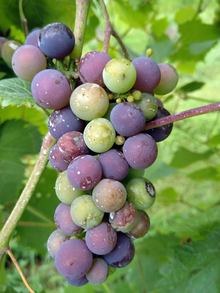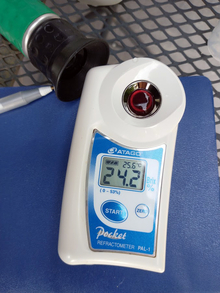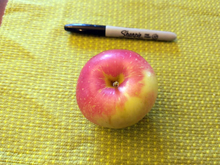A common mistake that home fruit growers make is harvesting the crop too soon, especially for grapes and apples. The color changes observed on the fruit do not necessarily align with full maturity.
It's easier to tell when berry crops are ready to pick through visual cues, such as changes to color, or the ease that the fruit comes off the plant (raspberry in particular). Those small fruits have a short and fast ripening period between bloom and harvest.
Although berry crops like strawberry, blueberry and raspberry can be picked using visual cues like color or taste to assess ripeness, figuring out when to pick apples and grapes is a bit more complicated. But there are some key techniques to follow.
How to measure grape ripeness
Grapes follow a growth curve with three main stages: berry formation, lag phase, and ripening. The first two of these phases are when the berries are obviously green and under-ripe.
The transition between the lag phase and into ripening is called veraison. Veraison is marked by the softening of the berry skin and pulp, the accumulation of sugars, a reduction in acidity, and a change in color.
Many home grape growers might think that this visual cue is an indication that the fruit has ripened, but it is more complex than that. The time from veraison to harvest can take several weeks in order for the grapes to ripen.
Even though all of the grapes on a bunch may have softened and changed color, they keep changing within the cluster until they are fully mature. Each berry is transitioning to increased sugar, reduced acids, increased anthocyanin (red pigments in red grapes), and development of flavor compounds.
Measure sugar content
For many cold hardy hybrid grapes, the longer the grapes can stay on the vine the better all of these attributes will be at harvest. Wine grapes in our region can approach 25 °Brix (degrees Brix is the sugar content of an aqueous solution), which is roughly 25% sugar, and may only be 12-14% sugar at veraison.
The varieties Brianna or Edelweiss are different - they can get an overripe flavor in wines when picked too late (over 18 °Brix). The total acidity can also be reduced by 30% or more through the ripening process so that berries go from being tart to balanced with sugar and acid.
In addition to using visual cues at veraison, monitoring the developing fruit for seed maturation can provide support for when to pick. Seeds should be brown, hard and fully formed in both apple and grape.
The use of a refractometer can provide an accurate sugar content (also known as soluble solids) reading. Many reference guides will lay out how to sample a vineyard for estimating a plot for commercial applications, but for the home fruit grower a small sample will often suffice.
- Crush or squeeze the fruit, and apply the extracted juice sample to the refractometer.
- Apply light and read the value. An analog refractometer uses the sun as its light source, and you look through the device to observe and record the value.
- Temperature influences the reading, so you may need to use calibration tables.
Digital refractometers are handheld devices that can compensate for changes in temperature. When selecting a refractometer for purchase, consider the range of values acceptable. Grape and apple can typically use a single refractometer, but if you are making jam, jelly, or maple syrup get a specialty device in the correct range.
How to measure apple ripeness
Apple ripening will vary greatly by variety and even within the canopy of a single tree. Apple orchards use visual cues, sugar content, loss of starchiness, and flavor to decide when to harvest.
They also know the approximate time in the season when each variety is picked. For example, Honeycrisp is typically harvested in late September through October, while Zestar! Is harvested in late August or early September.
Many producers use visual cues to harvest fruit, particularly the change of the skin’s background color and over color. Background color for most apples is green, and this lightens to a yellow color (for example a yellow Post-It Note color) as the fruit matures. The over color (red, red striping, red blush, etc.) can mask the background color and may vary by environmental conditions such as hot weather, especially warm evenings, that prevent color development even though the flesh inside continues to mature.
Apples typically change in texture through ripening as well, but varieties like Honeycrisp maintain that firm texture through harvest and into storage.
Other attributes to consider for apple ripeness include preferred flavor and the development of sugars. If the apple tastes “starchy” or dry on the tongue it is not ripe yet. Apples have a high proportion of starch that is converted to sugar during ripening (both on and off the tree).
In large-scale apple production, this transition from starch to sugar is monitored using a starch-iodine test where they apply an iodine solution to the cut surface of several fruit. The starch stains purple and produces a pattern that is informative when compared to a standard index for the variety. However, this method is not recommended for small-scale production like home gardens.
Acidity can also be measured (pH or titratable acidity) as an indicator of maturity. However, the specialized equipment for monitoring this feature is beyond the scope for most backyard hobbyists.
Is it ok to use taste to determine ripeness?
We recommend using taste as one gauge of ripeness but shouldn’t be the only method. Tasting can be a great way to determine maturity, but our mouths and other senses can play tricks on us. For example, high sugar can mask high acidity. High acidity can desensitize the tongue, making it difficult to assess later samples. And fresh fruit always seems to taste great right off the tree or vine, even if it is not actually at peak ripeness.
Collecting data throughout the growing season like bloom date, veraison (for grape) and keeping yearly records can inform when to harvest. Weekly monitoring for the slow-to-ripen varieties is a great way to track progress and an increase in monitoring as harvest approaches.
Of course, ripening fruit are attractive to other creatures that want the bounty you have cultivated. The high sugar content and aromatic fruits are attractive to insects, birds, and mammals like raccoons. You may need to pick your fruit earlier than planned to secure a crop.
Hillin, Daniel. Grape Berry Ripening and Sampling Techniques. July 2019. Texas A&M AgriLife Extension Service. https://aggie-horticulture.tamu.edu/vitwine/2019/07/15/grape-berry-ripening-and-sampling-techniques/
Fruit Harvest - Determining Apple Fruit Maturity. Oct. 25, 2017. PennState Extension. https://extension.psu.edu/fruit-harvest-determining-apple-fruit-maturity
Tong, Cindy. Check Apple Ripeness with the Starch Iodine Test. Aug. 29, 2018. UMN Extension. https://blog-fruit-vegetable-ipm.extension.umn.edu/2018/08/check-apple-ripeness-with-starch-iodine.html




